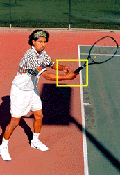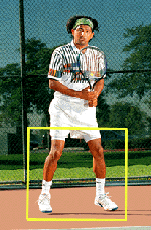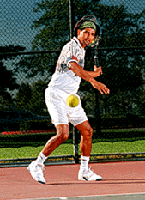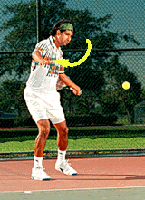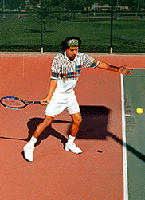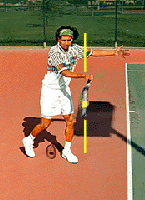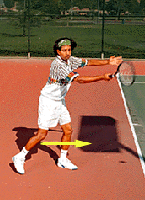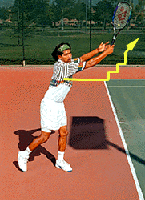|
TennisOne Lessons
Set Up Early for Maximum Power and Control by Monty Basnyat IntroductionAs a teaching pro, one of the questions I'm asked most is, "How come all my balls land short, with no power?" Obviously there could be many things going wrong. But my first answer is 1. Poor PreparationEarly preparation has both mental and physical components. Mentally, you must have a heightened sense of alertness, which will help you concentrate and see the ball early all the time. From the physical perspective, notice my poor preparation here. My racket head is down near my knees, which means I've got to get it out of the way to take my first step. Even that micro-second delay is too much. Notice my poor foot preparation. I'm standing flat-footed, with the knees locked. This means that there's no way I can take a quick first step or start my racquet preparation. 2. Poor preparation in action
With poor preparation, there is no racquet acceleration or transfer of weight. The only way to generate power is to muscle the ball over the net with your arm and wrist.
3. Preparing Early ere I'm ready to take my first step by concentrating on seeing the ball early. My racquet head is up, so when I turn my shoulders, my racquet automatically starts going back for the setup. My weight is balanced on my thighs, quadraceps, and calves, getting ready for that explosive first step. 4. Taking racquet back and beginning strokeWith a good shoulder turn, racquet setup and footwork, I'm now ready to start focusing on the contact point. Since my racquet is back and my shoulders are ready to uncoil, I'll have more arm and racquet speed as I move into the ball, resulting in more power and depth.
5. Hitting ball with correct point of contactBecause of my grip, my point of contact is just in front of my lead shoulder. If you use a continental grip, your point of contact should be just past your front shoulder (check with your local certified pro about your grip and your point of contact).
6. Long follow-throughAs you're reaching your point of contact, your transferring your weight towards the ball. After the point of contact, make sure you have a long follow-through. Visualize a long hallway with stairs at the end. Your racquet head and palms should go all the way down the hallway and up the stairs.
7. Drill: Taking Small HopTo prepare early, you must see the ball early. During drill or practice time, get into the habit of taking a small hop just before your opponent connects with the ball. In effect, the hop unweights you, allowing you to take a faster first step in any direction.
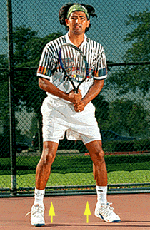
|

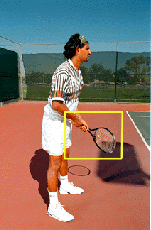 usually preparation. Early preparation is the foundation for good groundstrokes. Early preparation involves: 1) seeing the ball early; 2) reacting to the ball by turning your trunk and your shoulders (which should automatically initiate your racquet preparation); 3) starting your first step. Once these basic foundations are established, you're on your way to hitting the ball with more power and depth.
usually preparation. Early preparation is the foundation for good groundstrokes. Early preparation involves: 1) seeing the ball early; 2) reacting to the ball by turning your trunk and your shoulders (which should automatically initiate your racquet preparation); 3) starting your first step. Once these basic foundations are established, you're on your way to hitting the ball with more power and depth. 